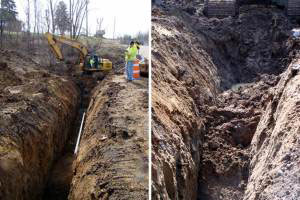 A month after a 33-year-old worker died while working in an unprotected trench, OSHA inspectors found another employee of the same Missouri plumbing contractor working in a similarly unprotected trench at another job site. OSHA determined that, in both cases, the company failed to provide basic safeguards to prevent trench collapse and did not train its employees to recognize and avoid cave-in and other hazards. OSHA issued 14 safety violations found during both inspections, and proposed penalties totaling $714,142.
A month after a 33-year-old worker died while working in an unprotected trench, OSHA inspectors found another employee of the same Missouri plumbing contractor working in a similarly unprotected trench at another job site. OSHA determined that, in both cases, the company failed to provide basic safeguards to prevent trench collapse and did not train its employees to recognize and avoid cave-in and other hazards. OSHA issued 14 safety violations found during both inspections, and proposed penalties totaling $714,142.
Trench collapses are among the most dangerous hazards in the construction industry.
Twenty-three deaths from trench and excavation operations were reported in 2016. In the first five months of 2017, at least 15 fatalities have been reported nationwide.
Gain knowledge, develop skills, and learn to recognize trench hazards by registering for Roco's Trench Rescue course. Our desire is for everyone to return home safely each day, and for this fatality number to not continue to increase.
Source: OSHA QuickTakes July 2017

 As Director of Training, I get many questions about rescue techniques and regulations from our students and readers. In the past month alone, I have received three inquiries about "timely response for rescue teams" regarding permit required confined spaces (PRCS). So, let's break it down and try to clear the air on this subject. For clarification, we will refer to the General Industry Standard 1910.146; the Construction Standard 1926-1211; and the Respiratory Standard 1910.134.
As Director of Training, I get many questions about rescue techniques and regulations from our students and readers. In the past month alone, I have received three inquiries about "timely response for rescue teams" regarding permit required confined spaces (PRCS). So, let's break it down and try to clear the air on this subject. For clarification, we will refer to the General Industry Standard 1910.146; the Construction Standard 1926-1211; and the Respiratory Standard 1910.134.

 In Non-Mandatory Appendix F (I hate that non-mandatory language), OSHA gives guidance on evaluating response times under Section A - Initial Evaluation. What are the needs of the employer with regard to response time (time for the rescue service to receive notification, arrive at the scene, and set up and be ready for entry)? For example, if entry is to be made into an IDLH atmosphere, or into a space that can quickly develop into an IDLH atmosphere (if ventilation fails or for other reasons), the rescue team or service would need to be standing by at the permit space. On the other hand, if the danger to entrants is restricted to mechanical hazards that would cause injuries (e.g., broken bones, abrasions) a response time of 10 or 15 minutes might be adequate.
In Non-Mandatory Appendix F (I hate that non-mandatory language), OSHA gives guidance on evaluating response times under Section A - Initial Evaluation. What are the needs of the employer with regard to response time (time for the rescue service to receive notification, arrive at the scene, and set up and be ready for entry)? For example, if entry is to be made into an IDLH atmosphere, or into a space that can quickly develop into an IDLH atmosphere (if ventilation fails or for other reasons), the rescue team or service would need to be standing by at the permit space. On the other hand, if the danger to entrants is restricted to mechanical hazards that would cause injuries (e.g., broken bones, abrasions) a response time of 10 or 15 minutes might be adequate. The following article was written by Russell Warn and published in ISHN magazine
The following article was written by Russell Warn and published in ISHN magazine 
 Determine the type/shape of the confined space: In an ideal scenario, each confined space area would be in an “even” or level position. This isn’t always the case, and a container may be placed on an inclined surface, making the highest point in the corner positioned toward the top of the inclined surface. Thus, entry may be nearer to where the heavy gases have accumulated.
Determine the type/shape of the confined space: In an ideal scenario, each confined space area would be in an “even” or level position. This isn’t always the case, and a container may be placed on an inclined surface, making the highest point in the corner positioned toward the top of the inclined surface. Thus, entry may be nearer to where the heavy gases have accumulated.





